Localization in Asia: How Spotify Conquered 6 Challenging Markets (Includes Japan Pre-Launch Case Study)
Missed Part 1 of this series? Read 9 International Growth Strategies Spotify used to acquire more than 100 million users (link here.)
“Everywhere in Asia”
“We want to be everywhere in Asia,” said Sunita Kaur, Managing Director for Spotify Asia to Bloomberg earlier this year.
3 years since Spotify’s Asia expansion, while not yet “everywhere” in the region, the company’s in great shape.
The music streaming service first launched in Asia in 2013, after 5 years and 25 million users worldwide in their global expansion. Their first 3 markets were Singapore, Hong Kong, Malaysia, followed by Taiwan and the Philippines in 2014, and Japan just last month. If their avoidance of China is any indication, this launch sequence is driven by strategy: the Japanese music industry, their latest venture, is notoriously difficult to break into. “Save the hardest for last” is one way to frame it.
All these new users are no doubt contributing to Spotify’s current stats: 100 million active users, 30 million of which are paid subscribers.
Success in Asia can be tricky. From language and cultural barriers, different bureaucratic and payment systems to different consumer habits and mode of e-commerce, costs of living, the list goes on.
So far, it looks like Spotify is winning its Asian markets.
While Spotify has yet to release any revenue data, a recent company-commissioned report by global market-research company TNS shows that its reach in Singapore alone is deep and growing.
If Spotify were a Singaporean radio station, it would be the 3rd largest by weekly reach. In fact, TNS reports that at least 2 out of 5 Singaporeans with internet connection are streaming on Spotify—that’s more music streaming in this market than ever before.
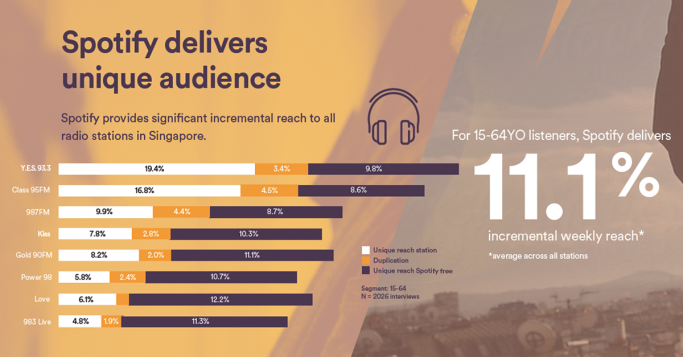
Throughout the rest of their markets in Asia, Kaur cites a 20% conversion rate from free to paid users. “We are now the only music company to actually provide music for free on a mobile device which some people thought was risky,” says Kaur. “What we’re really getting excited about is our user growth.”
Spotify’s success in Asia is no accident. As a continuation of our last article, this case study will cover:
- Sunita Kaur’s list of launch strategies unique to Asia
- How Spotify Asia applies the company’s growth strategies on-the-ground
- Spotify’s pre-launch tactics in Japan
- Spotify’s long-term growth plans in Asia and Japan
So what are Spotify’s best practices for dominating in Asia?
Don’t have time to read our full case study? Get the key points in our condensed Slideshare, at the bottom of the page.
Asia is a very different market than the rest of the world.
Of course, all markets are unique in their own ways. But one main challenge specific to the Asia market is its sheer diversity.
“The one main takeaway was understanding how different Asia is from the rest of the world,” reflects Kaur in an interview on her team’s Asia expansion efforts.

“Whereas in the US you’ve got 50 states but it is essentially the same culture and language, you come to Asia and even in just one country like India, for example, it’s almost like having 28 different countries within one because you have such different cultures, such different languages, everything.”
Question all your assumptions about what users are like across a diverse region.
Sunita Kaur’s suggestion when faced with very different markets across even one region: go back to the drawing board whenever you can afford to. Spotify’s best practice is “to not have a cookie cutter strategy that we use across each market,” said Kaur.
“With each country that we go into…we work with the big artists here… When we look at the music trends across all of the different countries, every country is very, very passionate about their local artists so it’s not just the big international stars that trend well across Asia.”
They try to invest in “build[ing] up a marketing story” in each new market. “It is kind of starting from ground zero in every country,” she adds.
Stay relevant in your local market through online channels.
Research your new market well and make sure you’re reaching out to your users through appropriate channels with relevant content. This applies not only to marketing but to your product and services as well.
Kaur revealed Spotify Asia’s strategy on staying relevant involves the following:
1. There is particularly high mobile adoption throughout Asia.
“A mobile first strategy was very important to us here,” says Kaur. “It made sense for us because everybody here lives on their mobiles.”
2. Targeting social media for distribution pays off.
A mobile first strategy meant Kaur’s team focused on social media as an active channel.
“When we launched this new feature people were talking about it in social media. Our best marketers are Spotify users.” LINE and Facebook are popular choices in many countries in Southeast Asia.
3. Speak the local language. Aside from translation, it’s key to stay on top of what’s on your users’ minds and producing great local content.
Sometimes this means keeping an ear on the local news and having a say.
When Singapore and Malaysia were affected with smoke from neighboring Indonesia’s forest fires, Spotify responded with a tongue-in-cheek special playlist, “Hazed and Confused,” featuring 40 fiery tracks like Billy Joel’s “We Didn’t Start The Fire” and Maroon 5’s “Harder to Breathe.” The playlist was a hit, with many social shares among local listeners.

4. Test and experiment which advertising channels are most effective.
With a growing consciousness among consumers for video advertising, Kaur and her team have started rolling out video ads in Singapore in April of this year.
“Our stable of offerings has been really about owning the ears and the eyes,” she said.
Singapore is the initial test country, with many more markets lined up this year. Kaur claims it will be a priority for the whole company moving forward.
Engage your target users offline.
Graham James, head of Spotify’s U.S. communications, says that their priorities for localization are: “launching great local content […] and building out a strong local team in the market.”
The local team’s presence is key for their offline events, which are essential to Spotify’s two-fold goals of engaging local listeners and empowering local musicians—who are also part of the platform’s target users.
One of Kaur’s priorities is to nurture the talent within each market. Spotify Asia has unique playlists in each market that promotes new, local music to listeners. In the Philippines, the company has held concerts featuring local artists, teaming up with local partners to enable showcasing artists within the local mainstream music industry, like in Hong Kong, or allowing listeners to vote and share their favorites at live events, like in the Philippines.
Meet your customers where they are: local offerings and payment systems
Spotify’s Asia strategy involves improving local content popular to target markets: this means prioritizing licensing for Korean pop music that’s all the rage in Southeast Asia.
Once they’ve got listeners and artists in the pipeline, Spotify Asia prioritizes investing in payment systems and partnerships that make the actual transaction easy.
[bctt tweet=”Keep in mind: “easy” payment systems is relative, and relies on local habits. ” username=”OneSkyApp”]
Kaur cites this as a major learning experience when they started expanding in Asia and Latin America, so they’ve depended on their partnerships with telcos.
“Our telco partners in Asia are an incredibly large part of what we do,” said Kaur to Campaign Asia. “There are so many amazing payment options out here, we’ve just got to make sure we find the right one for us.”
And find it they did.
Credit cards are a rare sight in Indonesia and the Philippines, compared to more developed markets, so Spotify offered cash payments for the very first time. They also made sure other popular options were available (such as bank transfer, ATM, Doku Wallet, and convenience store payments.)
Spotify also partnered with phone company Indosat Tbk PT for monthly deal packages, just as they had worked with Singtel in Singapore to launch unlimited mobile data streaming for Spotify Premium users.
Adjust your pricing based on local expectations.
It’s one thing to turn a profit—it’s better to do it while making your customers happy with your pricing. More satisfied users leads to more subscribers which gives you higher overall revenue in the long term, even if you offer your services at a lower price point.
This is the best practice that Spotify discovered when working in Asia, where the company offered different pricing based on the average incomes of its various Asian markets: Spotify Premium currently runs for USD $7.10 per month in Singapore, $6.20 in Hong Kong, around $5 for Taiwan, and less than $4 in the Philippines and Indonesia. All these are adjusted from the $10 rate for listeners in the U.S.
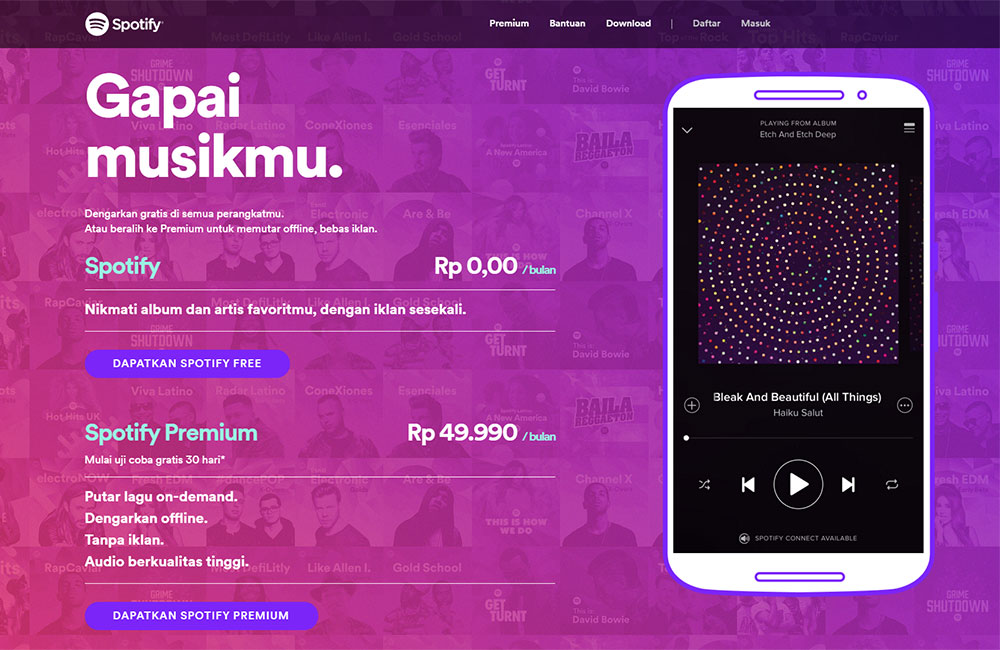
(To see how this applies to their global marketplace, check out this unofficial Spotify Pricing Index.)
Stay open to unexpected hits—and run with them.
Spotify Asia’s digital advertising portfolio, as Kaur puts it, has “such an eclectic mix of brands”—but they didn’t set out to win them in the beginning.
“When we started, we thought, ‘oh, we’re very consumer-related and automotive,” she remembers. This was the case until they started seeing financial institutions succeed in advertising on their platform. FWD Insurance in Hong Kong won 3 awards at mobile advertising Mob-Ex awards for their innovative ads on Spotify since 2014. “So, what we’re actually seeing,” says Kaur, “is yes, you can apply digital [advertising] and music to any brand out there and do it in very creative ways.”
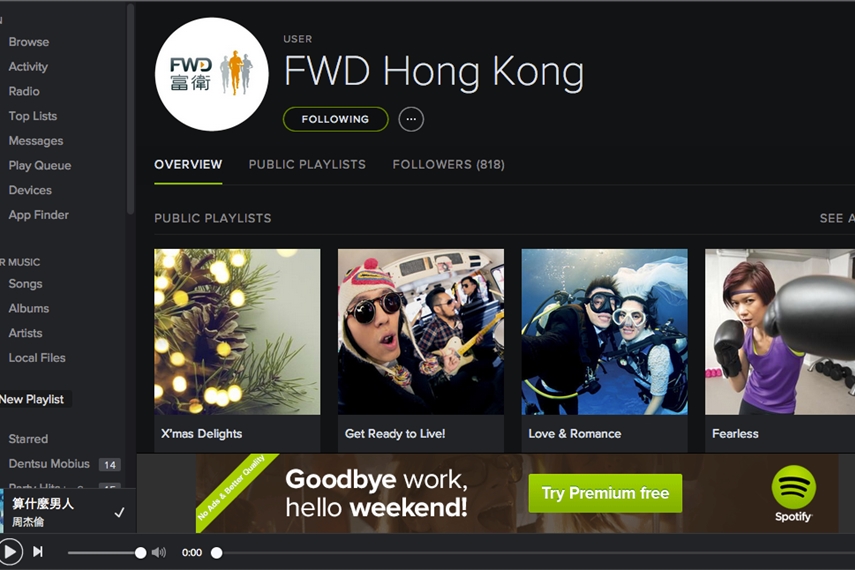
Launching Japan
After years of “Coming Soon,” Spotify finally rolled out as an invite-only service in Japan early this month to high expectations and major hurdles, many of which find its roots in lack of digital content—a surprising reality in Japan given its high-tech image and status as the world’s 3rd-largest economy.
One of Spotify’s local partners, Japanese ad agency Dentsu, agreed at the time of launch that despite being the 2nd-largest music market in the world at USD $3 billion in annual sales, “the Japanese [digital music] market remains nascent, with no single or widely accepted method to serve digital audio ads.”
In 2015, a handful of music-streaming giants, including Apple, Google, Amazon, Line, and AWA, all launched in Japan—but to little success. With high download rates and free trial periods to entice users, they nevertheless faced challenges converting listeners to paid subscribers.

Spotify is in a prime position to make a dent in the streaming service, since its completely free approach and ease of sharing among users is unique. Germany, a market similarly dominated by CD sales, was declining from 1998 until Spotify’s launch in the market reinvigorated music sales in 2012.
Yuma Sakata, head of Dentsu’s US Entertainment arm says Dentsu expects Spotify “to be a pioneer of digital audio ads in the Japanese market.”
While it’s still too early to tell whether the company is gaining ground in this uniquely challenging new market, here are some useful best practices we picked up from its pre-launch set-up:
Keep your future users in the loop.
Spotify does this simply through redirecting its new users to a “coming soon” page in a particular sub-domain. Here’s the one for Japan, which told visitors they were “preparing for launch”:
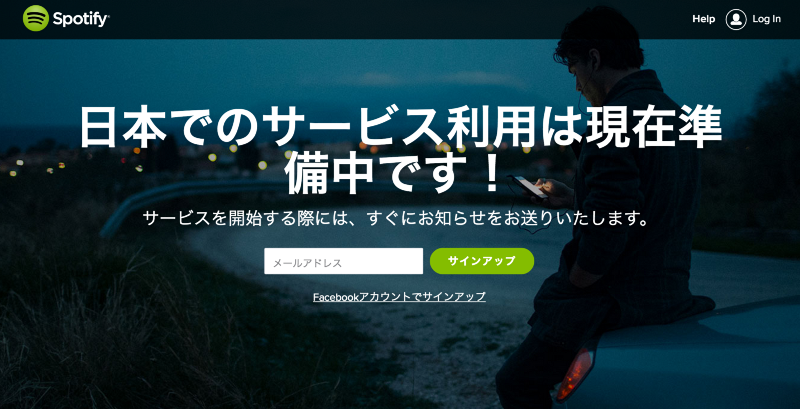
Figure out a new product fit for a new market.
To face the behemoth of Japan’s robust CD industry—which still accounts for 80% of music sales in Japan, a phenomenal figure for a medium already written off by the rest of the world as a tech relic—Spotify is gearing up to transform users’ mindsets towards not only their platform, but streaming at large.
This means maintaining Spotify’s status as a freemium music provider, ensuring the quality and selection of music, with emphasis on local content, with 85% of Japanese music fans in favor of domestic artists, according to Sebastian Mair, Tokyo-based president of Music Solutions, a music industry consultancy.
He says that Spotify’s current offerings has “major holes—the minimum to launch.” But given that no service “even has close to a complete [free] catalogue” this is a definite opportunity for Spotify in Japan, and in alignment with Spotify Asia’s overall strategy.
“We tend not to launch in a market until we have a very robust local music catalogue,” said Kaur last July. “Because we want to make sure that we’ve got very, very strong local music content.”
Aside from clear brand positioning, Spotify Japan needs to adapt their services to a market that’s “always its own world,” according to Mair. To this end, they’ve set up custom Gaming mode for the country’s high percentage of online gamers. They’ve also partnered with Sony PlayStation for karaoke lyrics support and will provide music for PlayStation Music as well.
Test your localization with your first local users.
Spotify is well-known for following an “invite-only” launch strategy in most of its new markets, gaining a solid and loyal user base over time.
But this beta-testing period is far from stagnant. The local Spotify team uses all the user feedback and signals they receive to improve their offerings, adjust product market fit, and investigate new ways to make their official launch a success.
Some of these product signals are “really coming from everywhere,” according to Sunita Kaur, and they end up affecting Spotify’s global service. “It is being able to take [the feedback] and then making the best decision you can for your users…”
“As we launch in more countries we’ll continue to learn by building for the user instead of just building a brand,” Kaur highlights.
Start building an experienced local team before you launch.
Before Spotify made any announcements of plans to expand to Japan, the company was already lining up its local players at the ground level, including beginning to hire for 12 members for its Japan team as early as January of 2016. They were also making moves to establish offices in Tokyo.
This comes from the deep understanding that the people matter—and people who understand the local consumer and business culture can make a huge impact. According to their job ads for the fast-growing team, Japanese fluency—and with it, understanding the cultural nuances inherent to the Japanese language—is a necessary requirement for most roles.
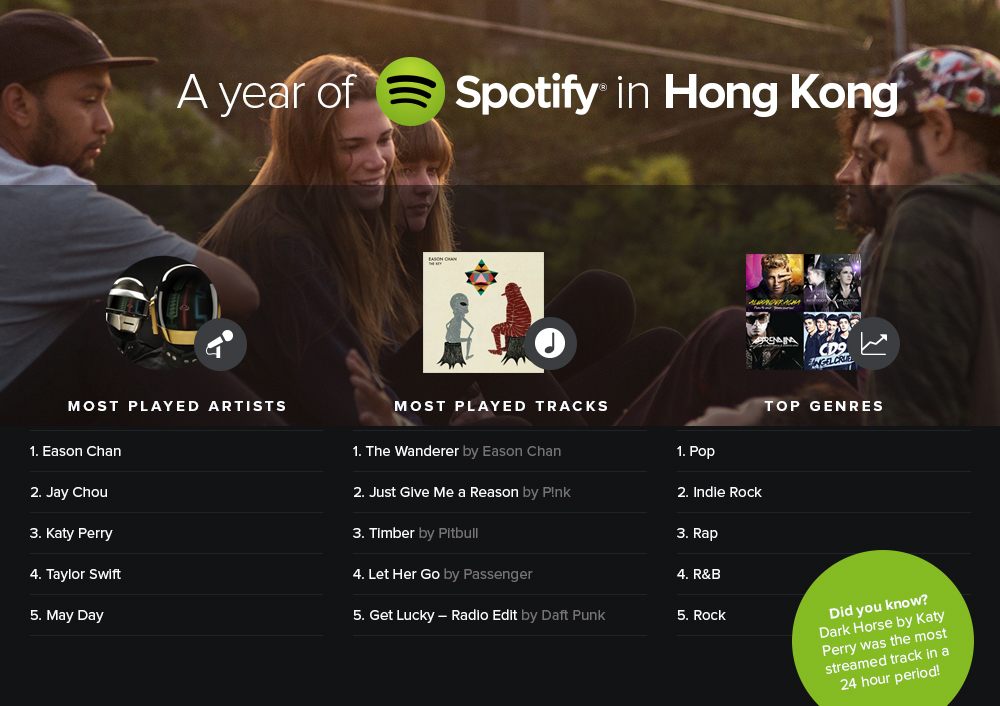
Always think in the long-term.
Even though the current Asian markets are keeping Kaur’s team “pretty busy” at the moment, they have plans to move to the rest of Asia and are always thinking about what’s next.
When asked whether the company is approaching breakeven, Faisal Galaria, Spotify’s head of global corporate and business development told paidContent:UK that they’re eyeing long-term success over short-term profits.
“We’re more focused on, rather than racing toward profitability, building a company that is in many, many countries. That takes a considerable investment to do that.”
Spotify has remained tight-lipped about whether it will try to take on China’s massive market, and the 99% pirated music proliferation that comes with it. For now, the company’s focus remains on its initial launch markets, but who knows? Maybe we’ll see a different headline in Chinese in a few years’ time…
Here’s a recap summary in Slideshare format, with some more details:
Your Turn
Interested in applying Spotify’s strategies in your own expansion into new markets? Get started with our free Essential Guide to App Localization (click below to download):
 hbspt.cta.load(1761271, ‘5b1156bb-27f7-4816-a39b-892b0930c8da’, {});
hbspt.cta.load(1761271, ‘5b1156bb-27f7-4816-a39b-892b0930c8da’, {});
About OneSky
OneSky provides seamless end-to-end localization solutions for thousands of mobile apps, games, websites, and businesses worldwide. We offer professional translation services in 50+ languages and a translation management system (TMS) with API integrations and plugins to streamline your workflow. We hire and carefully screen our own translators to ensure the highest control over quality. Using OneSky’s powerful QA features, cross-functional teams collaborate efficiently to deliver faster release cycles and higher quality translations. See how you can go global at www.oneskyapp.com



 Written by -
Written by - 


 Written by
Written by 

 Written by
Written by 



Great to come to your site as the information shared is good and is explained in simple words. Good stuff you are created, thank you for sharing a nice article.pip camera